Reprinted from Meridian Magazine (28 Sep 2006).
©2006 by John P. Pratt. All rights Reserved.
| 1. Heaven and Hell |
| 1.1 Sheep and Goats |
| 1.2 A Celestial Map |
| 2. Seven Angels |
| 3. 49 Constellations |
| 3.1 Seven Sisters |
| 3.2 Mapping the Heavens |
| 3.3 Perfect Pictures |
| 4. One Column Per Angel |
| 4.1 The Bright Stars |
| 4.2 Noah Presides in Paradise? |
| 5. Seven Roles Portrayed |
| 5.1 Moses |
| 5.2 Enoch |
| 5.3 Noah |
| 5.4 Peter |
| 5.5 Joseph Smith |
| 5.6 Abel |
| 5.7 Adam |
| 5.8 Twins Reversed |
| 6. Conclusion |
| Notes |
Perhaps the most surprising implication of these new interpretations is that the famous Perseus myth, upon which the movie Clash of the Titans was based, has many clear correspondences with the feats of the Prophet Joseph Smith. The reader is invited to consider the evidence which includes possible references to the first vision, the urim and thummin, and even the visit of Peter, James and John. Last month's article mainly referred to Biblical scripture, but this one of necessity involves an excursion into doctrines revealed in these latter-days. No extensive LDS background, however, is required to understand the ideas. Let us now embark on this odyssey through a realm of scriptures, stars, and sagas, keeping in mind that all of the ideas presented are strictly those of the author and do not represent any official doctrines of the LDS Church.
In latter-day saint (LDS) belief, there are three degrees of heaven: celestial, terrestrial, and telestial, which differ in glory as do the sun, moon and stars (see D&C 76, compare 1 Cor. 15:40-41, 2 Cor. 12:2). They are presided over by the Father, the Son, and the Holy Ghost, respectively. The underworld can also be thought of as having three levels: paradise, hell, and perdition. To understand this article it is necessary to understand something about who goes to each, and when each area is in operation.
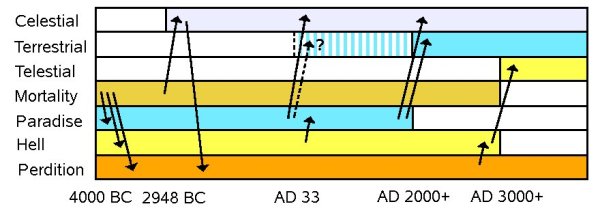 |
Figure 2 illustrates the various kingdoms and when each is populated. Since Adam, there have been people on earth, in paradise, in hell and in perdition. About 2948 BC Enoch's people became so righteous, living the law of the highest heaven, that their whole city was taken up into heaven (Moses 7:21) and began to populate that area. By that I do not understand that they were in the presence of God because their probationary period was not over, but rather they were in a place which became a temporary celestial kingdom. The Book of Enoch implies that later some of them knowingly chose to sin and became "fallen angels," and were relocated to suffer in the depths of perdition until the end of the world (Enoch 12:1-14:7).
When Jesus paid the price of sin and unlocked the gates of paradise, which had been like a prison even to the righteous (D&C 138:18, 50), those who qualified resurrected to the celestial kingdom. Their test was over and they had passed. Whether or not they physically joined the city of Enoch is not clear, but in the star figures both are shown as being in the highest heaven. To me it is not clear whether or not some or perhaps all of the remaining spirits in paradise then resurrected to be in the terrestrial kingdom. At least one scripture sounds like they did (Moses 7:56-57), but others might imply that all those in the terrestrial kingdom resurrect after all of those in the celestial (D&C 88:99). Hence Figure 2 shows a dashed arrow and hatched shading there to indicate that uncertainty. But we are told that while in paradise, the Savior also organized a missionary system there to teach those in hell, and give them a chance to accept his atonement and obey his teachings (D&C 138:30).
When the Savior comes again, a major event will happen. Those in paradise will be divided into two groups. Those who accepted the doctrines and ordinances of Jesus Christ are resurrected as celestial beings at the sound of the first trump (D&C 88:94-98). Those who were the honorable people of the earth who still knowingly chose not to accept all of the teachings of Christ are then resurrected into a terrestrial state at the second trump (D&C 88:99). It is not as glorious a place, but acceptable to its inhabitants where they can sit at the feet of the Savior. The earth itself will then be promoted to a terrestrial state, rather than telestial, so it becomes the temporary terrestrial kingdom. Another important point here is that after the terrestrial resurrection at the Second Coming, the doors of paradise are apparently closed and it shuts down. That is because the righteous born during the Millennium are changed in the twinkling of an eye, without sleeping in the earth (D&C 101:31).
What about those in hell? Those who accepted Christ before his Second Coming could graduate to the terrestial and even celestial kingdom. And those who did not are given yet another chance! To make the test easier (but the reward less), Satan is bound in chains after the Second Coming for a thousand years, and cast into the bottomless pit, so that he cannot deceive people into thinking that there is no God and no sin (Rev. 20:1-3). Then those in hell and perdition will have another thousand years to accept Christ, with no possibility of being deceived. At the end of that period there is a final Judgment Day. Those who have at last chosen to become sheep are then resurrected into the telestial kingdom. Those who still knowingly choose Satan remain as the stubborn, rebellious goats and are cast into the lake of fire of perdition (Rev. 20:15). An important point here is that the sheep in hell are finally resurrected to the telestial kingdom and then hell is closed. It is as if an entire class graduates! They are finally leaving the torments of hell, in some cases after nearly 7,000 years, and going to their rest in heaven, even if the lowest part thereof.
Is this not a wonderful Plan of Salvation, where the Lord gives us so many chances to turn from goats into sheep? He keeps calling and is so patient waiting for us to come to him.
Note that this latter presidency is especially confined to the earth and that their four stars are all located in the zodiac, near what is called the ecliptic circle (plane of the earth's orbit).
 |
Now for the logical extension of this concept. Even as the Savior referred to the general locations of heaven and hell, so also do the stars. All of the constellations above (north of) the zodiac represent heaven, and all of the constellations below (south of) the zodiac represent the underworld. Thus, in Figure 3, "heaven" is the upper hemisphere of sky north of the zodiac constellations, and "hell" is the underworld of constellations shown in the bottom circle. Notice that the upper circle contains many flying creatures such a Swan, Eagle, Flying Horse, an Arrow, and even a Dolphin which jumps out of the sea and "flies." On the other hand (left hand), the lower circle is filled with things below the earth, often represented by the sea, such as the Sea Monster, Water Serpent, River, Ship, etc.
The highest level of heaven, the celestial kingdom, is represented by the constellations nearest the center of the upper circle (the north ecliptic pole), the terrestrial by those near the middle, and the telestial by those nearest the zodiac figures. Similarly in the lower circle, paradise is represented by the figures just below the zodiac, whereas those nearest the center of the circle such as the Centaur and the Cross represent perdition. Now let us look at the roles of the seven angels in each of these areas at different times.
1. Peter and the Celestial Kingdom. First is the trump to announce those who resurrect to the highest heaven, the celestial kingdom, where God the Father dwells (D&C 88:94-98; 76:50 70). It was proposed that the first angel is Uriel, known in mortality as Peter, whose principal assignment is to preside over those valiant Christians who qualify for that highest heaven.
2. Moses and the Terrestrial Kingdom. The second trump is for the terrestrial kingdom, the second highest heaven, which is prepared for the honorable people of the earth who chose not to accept and live all of the teaching of Jesus Christ. It was proposed that the second angel is Raguel, known as Moses in his mortal probation, who has been like a shepherd to his people both in life and afterward, to prepare them to receive Christ either at his first or second coming.
3. Abel and the Telestial Kingdom. The third trump is for the telestial kingdom, designed for those who rejected the word of God, but who someday will bow the knee to Jesus. After death they suffer torment, and have to remain in hell until after the Millennium (D&C 88:100-101; 76:81-90, 98-112). Those in this kingdom do not enjoy the presence of either God the Father nor Jesus Christ, but are presided over by the Holy Ghost and ministering angels (D&C 88:86-88). It was proposed that the third angel is Sariel, known in life as Abel, and that one of his key roles is to preside over hell, and attempt to help its inhabitants repent and qualify for the highest kingdom possible. Abel was the first martyr and the first to enter the spirit world. In the Greek myths it is Hades who presides over the underworld, so Hades can be identified with Abel. After hell shuts down at the end of the Millennium, presumably Abel will continue to lead his "graduating class" in the telestial kingdom.
4. Enoch and Sons of Perdition. The fourth trump is for those who not only reject Jesus Christ, but also the Holy Spirit after having received it. Even after all of Satan's deceitfulness is exposed during the Millennium and those who mistakenly served Satan repent and turn to Christ, these will still willingly serve Satan by choice (D&C 76:25-38, 43-49). It was proposed that this fourth angel is Raphael, known in life as Enoch. He was translated to heaven (celestial kingdom) with his whole city. When some of those angels fell to the enticing of Satan, even after all that they knew, they became sons of perdition. Thus Enoch presided over a righteous city on earth (Moses 7:19-21), over his followers in the highest heaven, and also over the lowest of the low. But after the final Judgment Day at the end of the Millennium, Enoch's charge over them might end when they are cast out into the lake of fire with Satan (Rev. 20:10-15). Moreover, Enoch was known as "the scribe" and it is proposed that he acted as a secretary to the Presidency of Peter, Moses and Abel. As has been discussed, each of those four members presided over a different level of spirituality, and the areas of heaven and hell where such people reside. But it was proposed that Enoch served a double role, also being secretary to the following presidency.
5. Joseph Smith, Second Counselor. It was proposed that the Prophet Joseph Smith is the fifth angel, Phanuel, and that he functions as a second counselor in a presidency over all of the above individuals, but arranged into different groups. He is the counselor assigned to Zion, being the western hemisphere. He also has the special assignments of ushering in the Dispensation of the Fulness of Times, when all of the other six angels returned and gave him their keys and gifts so that the fulness of the Gospel would be restored on earth in preparation for the Second Coming of Jesus Christ. He also has the special assignment of the salvation of mankind, both the living and the dead, in a role similar to Jesus Christ in the First Presidency of Heaven of the Father, the Son and the Holy Ghost. He was even sacrificed as a lamb, as was the Savior.
6. Noah, First Counselor. It was proposed that Noah is the sixth angel, Gabriel, and that he also functions as the first counselor in the First Presidency of the Earth. He is assigned to the eastern hemisphere, where his ark landed after the great flood. He is also assigned to spiritual roles, comparable to the Holy Ghost in the Godhead. He presides over the restoration of the gospel (as Elias/Gabriel, D&C 27:6-7), likely including the pouring out of knowledge and blessings on the heads of the saints (D&C 110:9, 121:33).
7. Adam, President. The scriptures explicitly tell us that the seventh angel is the archangel Michael who will lead the armies of God to overcome Satan in the great war at the end of the Millennium when Satan is finally defeated forever (D&C 88:110-115). Michael was known during mortality as Adam (D&C 27:11), the father of our human family. It was proposed that he presides over all of the earth and all of mankind. Adam's duties almost all pertain to the earth, rather than heaven or hell.
 |
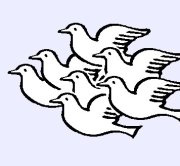 |
Figure 4 illustrates the resultant map. Some of the constellations need to be moved slightly to fit the pattern but to me it was amazing that it was possible to do at all. There were just enough constellations to make exactly three rows of seven above the zodiac, and also 21 in the lower regions. Those at the top of the table are in the northern sky and those in the bottom are in the south (as seen from the northern latitudes). When one faces south and sees those on the right in the west, then those to the left of them will be east of them.
To make the arrangement even more clear, look at the constellations nearest the center of the top circle in Figure 3. They are the Dragon at the very center, surrounded by the Little Bear, the King, the Swan, the Harp, and Hercules. That is only six and seven are needed. Possible candidates are the Flying Horse, the Arrow, the Crown, and the Queen, which are all about equally close to the center. Here an ancient tradition helps us, where we are told that Pegasus "beats his swift wings in the topmost circle of the sky."[6]. When all of the constellations are accounted for, it turns out that Hercules drops out of the top circle to be below the Dragon and the Crown is promoted to the top circle, being at the top of its column of constellations. Thus, the highest circle of the heavens is occupied by the Dragon, Little Bear, King, Swan, Flying Horse, Harp, and Crown. Continuing that manner of placement allows the entire table to be completed. One other adjustment was that it became clear that the Serpent Bearer and Serpent should be combined into one constellation because together they represent one angel, and the Twins (Castor and Pollux) should be separated because they represent two. The important thing is that the table is actually a map of the heavens, rather than being simply an arrangement designed just to reach the conclusions of this article.[7]
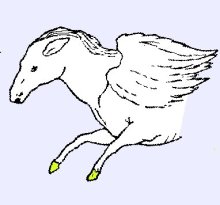 |
One thing that put me onto the significance of this arrangement, is that the bright stars in the sky mostly happen to fall where the angel performed his most important work. For example, Peter's main calling appears to be to preside over the celestial kingdom and the only bright star found in his column is Deneb, in the Swan, in the highest heaven. The only other bright star in the highest heaven is Vega in the Harp. That is in Enoch's column, and reminds us that he and his entire city were translated to heaven. If that coincidence is due to blind chance then we must ask what is the probability that the only two bright stars in the highest heaven would fall into the columns of Peter and Enoch? Before calculating that, let us first look at all of the other perfect positions.
The brightest stars in the sky which fall into these constellations are shown in Table 1. Just from what has been reviewed above of the duties of the seven angels, we see that each of the first four angels who preside over a level of spirituality has a bright star in their area: Peter in the celestial kingdom (Deneb in the Swan), Moses in the terrestrial (Arcturus in the Herdsman), Abel in the telestial (Capella in the Charioteer or Goatherd), and Enoch presides over the sons of perdition (Rigel Kentaurus in the Centaur). Moreover, Enoch also presides over his city in heaven (Vega in the Harp) and Abel presides in Hell (Procyon in the Little Dog). Of course, we have already covered the presidency of the earth with the bright stars for Adam (Regulus in the Lion), Noah (Fomalhaut in both Waterman and Southern Fish), Joseph Smith (Aldebaran in the Bull) and Enoch (Antares in the Scorpion and the Healer), all in the middle row. Thus those four cornerstone stars are part of this same expanded pattern that covers the entire sky.
| Moses | Enoch | Noah | Peter | Joseph | Abel | Adam | |
|---|---|---|---|---|---|---|---|
| Celestial | Vega | Deneb | |||||
| Terrestrial | Arcturus | Altair | |||||
| Telestial | Antares | Capella | |||||
| Earth | Spica | Antares | Fomalhaut | Aldebaran | Castor | Regulus | |
| Paradise | Fomalhaut | Pollux | Rigel | ||||
| Hell | Sirius | Procyon | |||||
| Perdition | Acrux | Rigil Kentaurus | Canopus |
I will not attempt to calculate the odds of each of these bright stars just happening to fall into the correct squares where those seven angels did their most important work, but they are clearly astronomical. It was seeing these stars all fall into place that convinced me to research further what could be deduced about the duties of each of these angels.
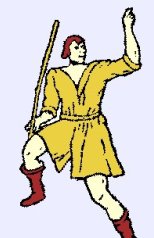 |
Think about the chance of all seven of these figures being perfect hits for Moses. Which other angel was raised by a queen as an infant? Who else was a shepherd? Who else had an experience with a cross? It was astounding as this pattern unfolded before me that it was possible to have all of this significance using a table which is a simple map of the heavens.
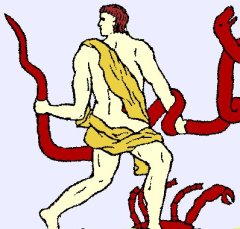 |
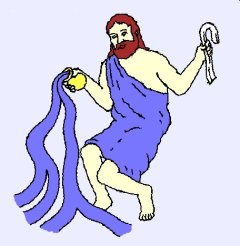 |
Jesus prophesied of the death of Peter:
He saith unto him the third time, Simon, son of Jonas, lovest thou me? Peter was grieved because he said unto him the third time, Lovest thou me? And he said unto him, Lord, thou knowest all things; thou knowest that I love thee. Jesus saith unto him, Feed my sheep.
Verily, verily, I say unto thee, When thou wast young, thou girdedst thyself, and walkedst whither thou wouldest: but when thou shalt be old, thou shalt stretch forth thy hands, and another shall gird thee, and carry thee whither thou wouldest not.
This spake he, signifying by what death he should glorify God. And when he had spoken this, he saith unto him, Follow me. (John 21:17-19)
How was this prophecy of Peter's death fulfilled? When did he stretch forth his hands, when was he girded by another, and carried where he did not want to go? Allow me to quote an excellent detailed account of Peter's martyrdom.
"Maliciously condemned, Peter was cast into the horrible, fetid prison of the Mamertine. There, for nine months, in absolute darkness, he endured monstrous torture manacled to a post. Never before or since has there been a dungeon of equal horror. . . . The Mamertine is described as a deep cell cut out of solid rock at the foot of the capitol, consisting of two chambers, one above the other. The only entrance is through an aperture in the ceiling. The lower chamber was the death cell. Light never entered it and it was never cleaned. The awful stench and filth generated a poison fatal to the inmates of the dungeon, the most awful ever known. . . . How Peter managed to survive those nine long dreadful months is beyond human imagination. During his entire incarceration he was manacled in an upright position, chained to the column, unable to lay down to rest. . . .
"Peter, the Rock, as he predicted, met his death at Rome by the hands of the murderous Romans, who crucified him, according to their fiendish manner. He refused to die in the same position as our Lord, declaring he was unworthy. Peter demanded to be crucified in the reverse position, with his head hanging downward. Ironically enough, this wish was gratified by the taunting Romans in Nero's circus A.D. 67"[9]
Peter was an astounding example for all of us. It was said that during his suffering he was always praising God, and that 47 of his guards were converted during those nine months. The purpose of the two chambers was to keep the lower chamber in total darkness all the time, even when he was being given his meager rations. Most men imprisoned there went mad and died in a few weeks, so it is indeed amazing that Peter could survive so long and so well.
To me the Savior's prophesy has a double meaning. Peter's outstretched hands were girded (manacled) and he was taken to the Mamertine prison, where he did not want to go. Then again his outstretched hands were girded (nailed) to a cross. Truly the precise manner of his death was foreseen by the Savior. But how far ahead of time was it foreseen?
Getting back to the constellation symbolism we see the Chained Princess, representing the Christian church, and also Peter as its leader, manacled with arms outstretched. And we see the fishes also shackled by the Bands to the Sea Monster from perdition.
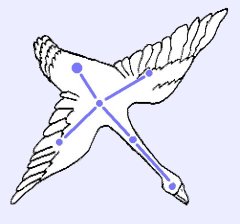 |
There is no doubt in my mind that the answer is yes, because the symbolism is too clear and too perfect. The Swan is Peter's principal constellation because it is in the celestial kingdom row, the place of his calling. I have taught astronomy students for thirty years that the head of the Swan is at the foot of the Northern Cross with no thought that there was any connection. Now that my eyes have been opened to see the deeper meaning as this article was being written, that constellation will never be the same.
The Queen, another symbol of the Church, also fits well in this column also, so this column gets a score of seven out of seven meaningful figures.
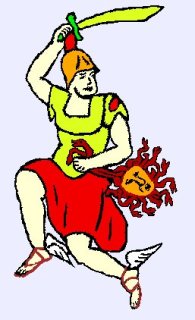 |
The Seven Sisters represent all seven of the angels. Why should that constellation fall in the column of Joseph? Is it not because all seven are part of his story? The other six (and only six are visible) all came to visit him and bestow their authority and priesthood keys upon him. Joseph presides over the dispensation of the Fulness of Times, when all things come together, and to me that is part of the symbolism of the Seven Doves. The dove also symbolizes the Holy Ghost, who presides over the telestial kingdom, along with ministering angels. Note that this constellation is found on the level of that kingdom, hence seven doves seems like ideal symbolism for those ministering angels in that role.
Perseus Myth. The best known myth to astronomers is that of Perseus because it involves seven constellations in the late summer sky. The myth has been on my website for years for my beginning astronomy class to memorize to tell around the campfire.[10] That constellation of the Hero (Perseus) falls into the column of Joseph Smith, so let's review part of it to see if it might relate to his life in some way.
Perseus became obligated to obtain the head of the horrible Medusa, who had snakes for hair, and her face so ugly it turned any onlooker to stone. As he began his quest, he went to a sacred grove, where he was told that the gods would help him. Soon he met a messenger of the gods who gave him a hardened sword which could not be broken by Medusa's scales. It had been made by Hephaestus, the blacksmith god who worked underground. Then Athena appeared and gave him her polished brass breastplate, which he could use both as a shield and also as a mirror in which to look at the abominable Medusa indirectly, to avoid being immobilized. The messenger, who carried a winged staff, also unfolded a plan to obtain three more gifts he needed, which Perseus executed as follows.
First he had to go across the great ocean to Mount Atlas and snatch the one eye shared by three seeresses known as the Gray sisters, who looked like swans. He did so and refused to return it until they told him the location of the Nymphs of the North. It was said that their land beyond the North Wind was not reachable by land nor sea. After learning of their hidden location, Hermes took him there, where he received a) winged sandals enabling him to fly, b) a magic silver pouch to safely carry the Medusa's head, and c) a helmet of invisibility made by Hades in the underworld. Thus equipped, he successfully slew the Medusa and returned with her head in the pouch. There is much more to the story, including saving the Chained Princess from the Sea Monster, but this is sufficient for our purposes.
Does all of this have anything to do with the Prophet Joseph Smith? For starters, his experience also began in a sacred grove, where he learned that he would be an "annoyer" to the powers of darkness (JSH 1:19-20). Then a messenger from God appeared to him and provided him with two sacred gifts. One was the double-edged sword of the word of God (Eph. 6:16-17, Heb. 4:12, D&C 6:2), written on golden plates by the dead in the underworld. The other was an actual brass breastplate (D&C 17:1), "such as was used by the ancients to defend the chest,"[11] with two stones in silver bows attached to it called the urim and thummim, into which he could look to see things (JSH 1:34-35, 59; D&C 17:1). The fact that both of these gifts match so precisely in detail what Perseus was given clearly points to Joseph Smith as being Perseus. If so, we might want to ponder the implication that these details about a vision in a sacred grove, and the gift of a breastplate of armor used not for shielding blows but rather for seeing, were known thousands of years ahead of the event and important enough to be "written in the stars."
Moreover, there was also an ancient physical sword of fine steel associated with these two gifts called the sword of Laban, but it is not clear that Joseph was actually ever given that sword. It seems rather to have been a physical symbol of the spiritual sword of the word of God which Joseph would wield.[12]
The high priest of Moses also had a urim and thummim attached to his breastplate of judgment (Exo. 28:30, Lev. 8:8). Here we might note that Athena was the virgin goddess who is sometimes shown holding the balance of justice. The two zodiac signs in the column of Moses are the virgin Maiden and the Balance. Thus, Moses can be identified with Athena, and the breastplate with urim and thummim similar to that of the high priest. The Medusa had been a beautiful maiden until committing fornication in the temple of Athena (temple of Moses), after which Athena turned her into a monster. As we shall see below, the Medusa might tie to the wicked harlot who has prostituted her religion.
Joseph Smith was then given a series of priesthood powers and keys from all of the other six angels. One of the first of these was from Peter (accompanied by his counselors James and John). We have seen that the seer Peter has the Swan for his constellation, so the three "swan women" whom Perseus visited relate directly to the three swan seers of Peter, James, and John. Moreover, Joseph Smith remarked that John was working with the lost tribes of Israel,[13] so John would be ideal to reveal their location beyond the North Wind.
One pertinent detail is that Perseus had to go across the great ocean in order to talk to the Gray sisters, who guarded Mt. Atlas. Where was Mt. Atlas? That has puzzled scholars, who think Mt. Atlas is in Africa, across the Mediterranean Sea from Greece. A big clue is that the Garden of Hera with the golden apples guarded by the dragon was at the foot of Mt. Atlas. That garden clearly represents the Garden of Eden. Isn't it interesting that Joseph Smith identified Missouri as the land where the Garden of Eden had been, and also the location of the Mt. Zion spoken of in scripture and the future city of Zion (D&C 57:2, 76:66, 84:2). Joseph was required to go to Zion, even as Perseus was required to go all the way across the (Atlantic) Ocean to Mt. Atlas. To me that is an amazingly accurate detail to have been included in the saga. But maybe it should not be so surprising because Enoch, founder of the city of Zion, most likely wrote the myth.
If Perseus really is Joseph Smith, then what was the helmet of invisibility that Joseph received from Hades (Abel), lord of the dead? Perhaps the helmet was death itself, for perhaps only as an invisible spirit could Joseph decapitate the Medusa, and finish the work he began in mortality. Similarly, the winged sandals which he was given to rapidly fly where he wished fit perfectly with the ability of a spirit to travel almost instantly to a desired destination. As for the silver pouch, no clear interpretation is immediately apparent. There is much more left to be understood about the Perseus myth, but there is no doubt to which of the seven angels it refers.
The Big Dog and Hare. A second witness that this interpretation is correct is that both the Big Dog and Hare are also in Joseph's column. The dog is a greyhound in pursuit of the wicked, promiscuous hare. That sounds very similar to the quest of Perseus for the death of the Medusa. Thus, it appears that one of the special callings of Joseph Smith, as both Perseus and the Big Dog, is to help destroy the prostituted religion and/or secret combinations, which had caused him much grief during mortality.
The other constellations in Joseph's column are the King and the Champion (one of the Twins). Although Joseph was Mayor of Nauvoo, and running for the U.S. Presidency when he was martyred, the King more likely refers to a role of his in the celestial kingdom, where the sign is found. Let us now turn to his role as Champion in the discussion of the other twin, the Warrior, in the next column.
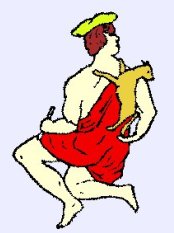 |
Another of the constellations in Abel's column is the Ship, named Argo in mythology, which carried many on a successful quest to obtain the golden fleece. It was led by Jason, who again seems to be Abel, and the quest was seeking the golden fleece of the Ram (eternal life). Both the Little Bear and Big Bear are in this column, and they probably represent other flocks, one being in the terrestial kingdom row, and one in the celestial kingdom. The Persians show these three constellations as three women, one of the symbols for the church. Did Abel have responsibilities for three flocks? Do the three goats also represent these flocks?
To me, the answer must be affirmative, with one of those flocks headed for each of the celestial, terrestrial, and telestial kingdoms. It is my understanding that even those who have been wicked in mortality and are consigned to hell, if they repent in time (before the Second Coming), they can still inherit the celestial kingdom. If so, then Abel was indeed presiding over three levels of spirituality represented by the two bears and the ship. Note that the sizes of these constellations is probably important. The smallest group is the Little Bear, the next larger is the Big Bear, and the huge constellation is the Ship. Those sizes could well represent the relative number who finally inherit each kingdom. Similarly, as the Goatherd, he is caring for three goats, a large one and two kids. Again, the large one would represent the biggest group of telestial beings.
The Twins. In this context, the Twins are two separate constellations. In the sky, one is clearly above the other, and in the table of 49, the one in Abel's column, the Warrior, is on earth, while the one in Joseph's column is in Paradise. In mythology, the Twins are Castor and Pollux, and there are bright stars with those names at the head of each twin. Castor was a warrior, being an expert swordsman, and Pollux was a champion boxer, so I have chosen the names Warrior and Champion for English translations of their symbolism.[14]
Who are these twins? Are they not the same as the Big Dog and the Little Dog, also found in those two columns? Castor represents Abel, and Pollux represents Joseph Smith. As for the boxing, to me it was clearly originally "wrestling," but has been mistranslated somewhere along the long line. Joseph Smith was famous for his championship wrestling ability, and was able to throw other expert wrestlers.[15] He even defeated a bully in order to raise money to free his friend Porter Rockwell from prison.[16] It would be hard to write a biography of Joseph Smith without mentioning that he was a champion wrestler, and apparently even the biography in the sky depicts this prowess. Thus, the Twins could probably also be called the Wrestler and the Swordsman.
The mythology here seems revealing. The twins were both aboard the ship Argo and between them they saved its passengers on a few occasions. The world's greatest bully would not allow the Argonauts to leave until one of them had fought him. Pollux accepted his challenge, side-stepped his advances, and won the contest. Thus, Pollux was a champion in both senses of the word: he was the best at his sport, and he used that skill to champion the cause of his shipmates and help save them. Note also how much the fight of Pollux correlates to Joseph Smith, who threw a bully to save someone in prison. Thus, the Twins became the patron saints and saviors of shipwrecked sailors. Poseidon, the god of the sea, gave them both white horses to ride.
But there is more to their story. Castor was slain first and Pollux mourned for him and avenged his death. Later, when Pollux was awarded immortality in heaven, but Castor was not, Pollux refused to accept it without his brother. Therefore Zeus allowed them to take turns, with one being in heaven while the other was in the underworld. What is all that about? Again, let us think about who has what assignment. If Abel (Castor) presides over hell until the end of the Millennium, then he would not be allowed to go to heaven with his brother Joseph at the beginning of that era. It sounds to me like the love of Joseph for his spiritual twin Abel is so great that perhaps it has been worked out that they will alternate presiding in hell during the Millennium. If so, then Castor and Pollux should indeed both be the patron saints of the sailors on board the Argo.[17] Another point here is that sailors would sacrifice a white lamb to bring their help, and the white lamb is indeed symbolic of both Abel and Joseph who were each sacrificed as a pure and innocent lamb.[18]
The other constellation in Abel's column is the brightest of all, being the Hunter (Orion). Both of the Dogs are apparently the Hunter's dogs, so in that context, the Hunter is definitely part of Abel's story, for the Little Dog serves its master. But who is the Hunter? In last month's article we noticed that the Hunter is depicted holding the lion's skin, wearing a belt of pearls, and wielding a club, all of which are indications of Hercules. Now we see that Hercules and the Hunter are one and the same person in this context, namely Adam. Adam is definitely part of the story of Abel, being his father. But Adam is also the father of the entire human family, and he is the archangel whom all of the other angels serve. Adam is the Hunter King who is seeking to destroy the Hare, but who delegates much of the job to his twin sons, Abel and Joseph Smith. Let us now turn to the deeds which capture the focus of the great one.
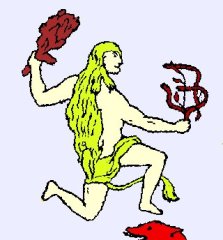 |
Hercules actions caused the deaths of all of his children, for which he was afterward remorseful. Is that not symbolic of the fall of Adam, who indirectly caused the death of all of his posterity? To pay penitence, Hercules had to perform twelve great labors, but let us focus only on those shown in the stars. Hercules triumphed over the Dragon which guarded the golden apples in the garden of Hera. That clearly alludes to the fruit of the Garden of Eden, "guarded" by the serpent, who was really the Dragon Satan in disguise. The scriptures tell us that Michael (Adam) is the angel who ultimately defeats the dragon, the "old serpent, called the Devil, and Satan" (Rev. 12:7-9). We see Hercules defeating the Dragon in the heavens, where his foot is squarely on the head of the Dragon in the center of Figure 3. Thus, the identification of Hercules with Adam seems clear. Hercules was the greatest hero, and Michael is the archangel. Besides, which other angel caused the death of all of his children?
Hercules' first labor was to kill the Nemean lion (the Lion). That lion's hide was impervious to any weapon, so he strangled it. He then made a garment for himself from its pelt to be a shield and a protection, and used its gaping mouth as a helmet. Note in the constellation figure, Hercules is shown wearing the lion skin garment. Then Hercules had to destroy the many headed monster Hydra, a giant Water Serpent who dwelt in a swamp. When he cut off one head, two would grow in its place. While fighting the Hydra he was also attacked by the Crab. He stomped on the Crab with his foot and called for the help of his Charioteer, who burned the stumps as each head was lopped off, which prevented new ones from growing. We see in his column of the heavens both the Crab and Hydra, found in the telestial kingdom and perdition rows. We also now recognize the Charioteer (or Goatherd), identified as Adam's son Abel, would be ideal to help his father.
Who do the Hydra and Crab represent? Are they not the same as the seven-headed monster in Revelation, and his helper, the second beast who enticed all to worship the first beast (Rev. 12:1-12). Both of these two, the beast and his false prophet, were finally overcome and were cast alive into the lake of fire and brimstone at the beginning of the Millennium (Rev. 12:20). Then finally, after the Millennium, the Dragon is also cast into the same lake where both the beast and the false prophet are (Rev. 20:10). Thus we see the Dragon, the seven-headed monster from the sea (Hydra), and the false prophet (Crab) are three distinct entities, and each is represented by a separate constellation in Adam's column. Note also that two of these constellations are out of place. The Dragon is pretending to be God, sitting on the throne at the top of the sky. Similarly, the Crab is also located in the lowest heaven, pretending to be a prophet of God. As a symbol of Christ the Crab represented the Deliverer; it would not be surprising if the false prophet also promised to deliver the downtrodden from oppression. Indeed, he is the prophet of the Dragon, an anti-Christ, a beast that appears as a lamb (Christ) but who speaks as a Dragon (Rev. 13:11).
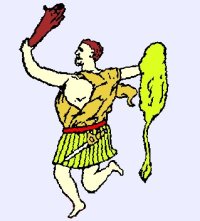 |
What is the symbolism of the Raven? That sign is found in the paradise row. To me it represents any of the dead who are in the spirit prison. We saw in an earlier article that Noah's raven, who went "to and fro in the earth" was identified with Satan who did likewise (Job 1:7).[20] But, being in paradise suggests that the Raven can also represent the righteous dead. The Raven is shown attacking the Hydra, implying that he is on the righteous side of that battle. And what of the Cup which also is shown on the back of the Hydra? As it last month's article, it could represent both the Cup of the wrath of God poured out on the Hydra, and also the harlot (Hare) who rides the back of that monster.
Thus, Hercules is not only identified as Adam, but also is the Hunter (Orion), the brightest constellation of the sky. He has two principal helpers in his hunt for the wicked Hare, being the Big Dog (Joseph) and the Little Dog (Abel). Note that both Abel and Joseph were slain by secret combinations (the Hare), so it is not surprising they both seek to destroy her. Thus the ancient myths seem to tell us much about the work of these chief angels.
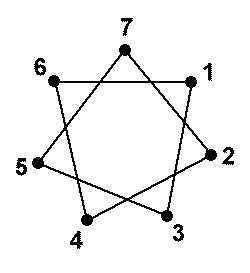 |
 |